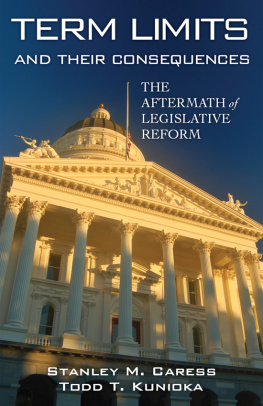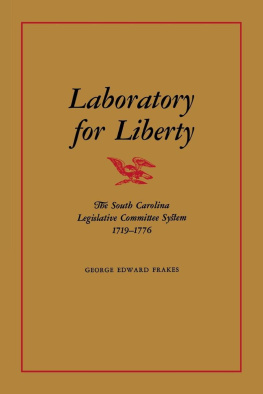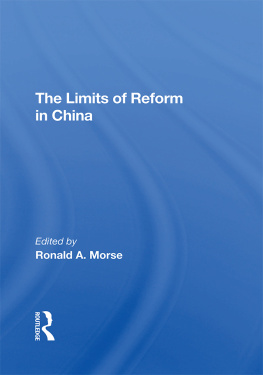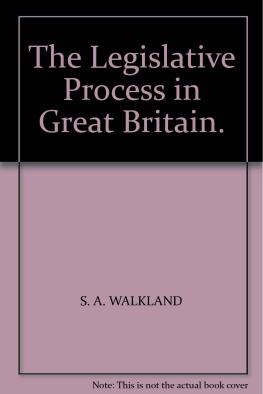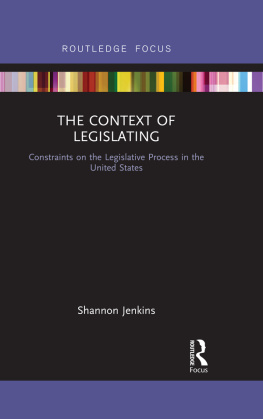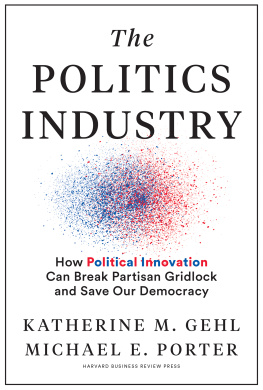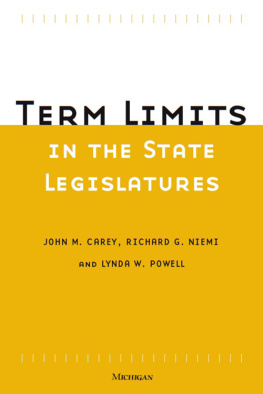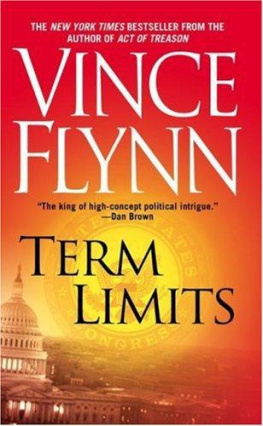TERM LIMITS AND THEIR CONSEQUENCES
The Aftermath of Legislative Reform
Stanley M. Caress
Todd T. Kunioka
Cover photo of the California Capitol Building Mark Rasmussen / Dreamstime.com
Published by State University of New York Press, Albany
2012 State University of New York
All rights reserved
Printed in the United States of America
No part of this book may be used or reproduced in any manner whatsoever without written permission. No part of this book may be stored in a retrieval system or transmitted in any form or by any means including electronic, electrostatic, magnetic tape, mechanical, photocopying, recording, or otherwise without the prior permission in writing of the publisher.
For information, contact State University of New York Press, Albany, NY
www.sunypress.edu
Production by Diane Ganeles
Marketing by Michael Campochiaro
Library of Congress Cataloging-in-Publication Data
Caress, Stanley Malcolm.
Term limits and their consequences : the aftermath of legislative reform / Stanley M. Caress and Todd T. Kunioka.
p. cm.
Includes bibliographical references and index.
ISBN 978-1-4384-4305-8 (hardcover : alk. paper)
1. United States. CongressTerm of office. 2. LegislatorsTerm of officeUnited States. 3. LegislatorsTerm of officeUnited StatesStates. 4. Term limits (Public office)United States. 5. Term limits (Public office)United StatesStates. I. Kunioka, Todd T. II. Title.
JK1130.C35 2012
328.73'073dc23
2011037289
10 9 8 7 6 5 4 3 2 1
TABLES
ACKNOWLEDGMENTS
There are several people we must thank for their help and assistance in the writing and preparation of this book. We are grateful for the help of Anita Immele, the former Department of Political Science Office Administrator at the University of West Georgia. Her expert knowledge of the English language was invaluable in the preparation of our manuscript and we are deeply indebted to her. Our old friends Steve Sanders and Kate Karpilow provided us with a vast array of interesting ideas and gave us access to a network of Sacramento insiders that produced insights many scholars could have easily missed. We are grateful for Clyde MacDonald and Peter Detwiler's willingness to share their knowledge of the internal workings of state government. We also posthumously thank the late Dr. Tim Hodson, former Executive Director of the Center for California Studies at the California State University Sacramento, who gave us valuable inside the Capitol information. Moreover, we were honored that former California State Senator John Vasconcellos granted us so much of his time to recount his personal memories and explain his vision of the future of state politics.
Early in our research, we had a beneficial collaboration with a team of scholars from Wayne State University. We are very happy that Jean-Philippe Faletta, a Ph.D. student at the time, invited us to cooperate with members of his department at Wayne State on a panel chaired by Malcolm Jewell at the American Political Science Association Annual Conference. We greatly appreciate the subsequent generous exchange of information that occurred between us and the Wayne State team consisting of Marjorie Sarbaugh-Thompson, Lyke Thompson, Charles Elder, John Strate, and Richard Elling. Their important work is cited numerous times in the book.
We are thankful for the assistance of Dr. Michael Rinella and the other good people at SUNY Press who believed in this project and helped bring it to fruition. Finally, we want to thank our wives, Lori Beth and Caroline, who encouraged us and gave us the support needed to make this book a reality.
INTRODUCTION
N o American legislative reform attracted more attention during the last years of the twentieth century than term limits. Unlike most legislative changes, which come from within the government, term limits were the result of pressures from outside government. The desire to restrict the length of time incumbent legislators could serve in office was so widespread that it generated a popular political movement that conducted petition drives to put the measure on state ballots all across the country. Once on the ballot, term limits proved to be very popular with voters and with only a few exceptions, passed, often by large margins.
The effort to have term limits placed on legislators is a fascinating example of state-level grassroots politics. It illustrates how a small number of political activists can dramatically alter government operations. It also shows how direct democracy provisions found in many states' constitutions can be used to impose significant restrictions on elected officials. The establishment of term limits also demonstrates how a seemingly minor alteration to the electoral system can have profound consequences on the legislative process.
WHY STUDY TERM LIMITS?
On the surface term limits may seem like only a small change in the way legislators gain and retain office. Term limits, technically, only restrict the number of times an incumbent can be reelected and place no further regulations on how legislators seek office. However, while term limits appear to affect only a limited number of incumbent politicians, their impact on the political system has been far-reaching. Restricting incumbent legislator tenure has completely reshaped governmental power in the states that have adopted term limits. Term limits, by changing election rules, have altered the selection of the people who make laws, and thus they have had a major influence on public policy. They have dramatically changed the composition of legislative bodies and impacted the authority of the individuals who lead them. They have altered the way legislatures function, and even, in some cases, changed the balance of power between the legislative chambers and the executive branch. Term limits, therefore, need to be studied because their impact has been so significant.
Additionally, in a more academic sense, studying term limits helps further an understanding of the role of popular political movements in the governmental process. Examining term limits and the politics that surround them helps answer the question of why a seemingly innocuous electoral modification provided the impetus for so much grassroots activism. It also helps explain why they generated such contentious debate between advocates and opponents. Several questions with major ramifications that need to be examined include: Why did restricting the years that elected lawmakers can serve in office become such a major concern for so many political activists? Why did term limits prove to be so popular with the voting public? How could this seemingly minor electoral technicality generate so much passion both inside and outside government? The answers to these questions are far from simple, and are themselves a subject for debate.
The final most important goal of a study of term limits is to discover their real impact on American government so that scholars and citizens in the future can render judgment on their effectiveness and desirability. This book discusses the early predictions about term limits and explores the evidence to see which ones turned out to be true. Only after a comprehensive examination will it become clearer whether the claims of term limit supporters were more valid than the rival contentions of their opponents.
HOW TERM LIMITS HAVE BEEN STUDIED
In the decade and a half since the beginning of their adoption, the methods used to examine term limits and their consequences have gone through a complete evolution. The original debate surrounding term limits contained more political rhetoric than academic study. Term limit advocates and opponents could only conjecture about the ramifications of changing the rules of legislative elections because of the absence of any systematic scholarly inquiry. To compensate for the lack of credible scholarship on the impact of term limits, some preliminary academic studies conducted in the early 1990s attempted to project the impact of term limits by using data from non-term-limited legislative bodies. These early projections, however, were limited by a lack of substantive evidence necessary for valid analysis. The type of evidence needed could only be collected after term limits were fully implemented and their impact felt. Such data only started becoming available in 1996, when the first forced retirements began to occur. From this point on academic interest in the subject expanded rapidly, and numerous studies that used a variety of approaches were conducted. Definitive conclusions about the consequences of term limits, however, remain elusive because their full impact has not been completely realized even after nearly two decades, especially in states that have more generous limits ().


